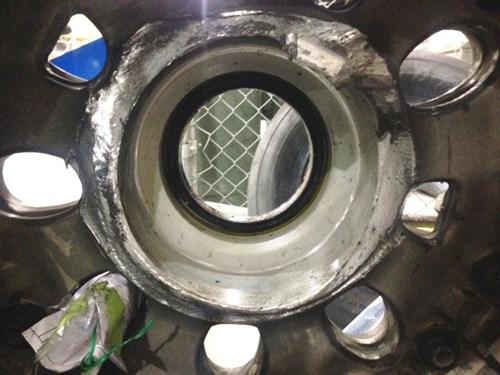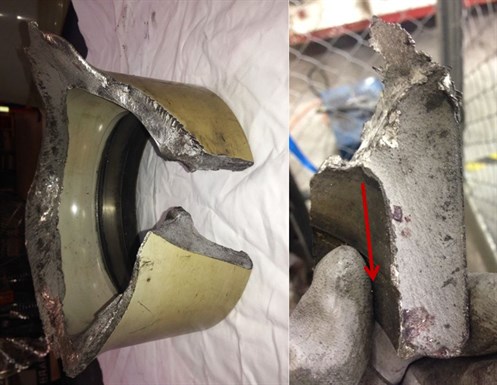What happened
On 10 June 2014, a Boeing 737 aircraft, registered ZK-ZQB and operated by Jetconnect Limited landed at Sydney Airport, New South Wales. During taxiing, the crew felt a slight shuddering from around the main landing gear; they also observed that they required a higher-than-normal thrust to taxi the aircraft. At the crew’s request, personnel in the Air Traffic Control tower and a passing aircraft observed ZK-ZQB, but did not see anything abnormal. The crew then requested that Rescue and Fire Fighting Services conduct a close-up inspection. They advised the crew that pieces of metal had fallen onto the runway and that the right, outer main wheel was leaning over. After parking the aircraft, an examination by Licenced Aircraft Maintenance Engineers confirmed that the inboard wheel half-hub had fractured into several pieces and that the wheel bearings were intact.
Inboard wheel half remnant

Source: Aircraft operator
Wheel hub failure
The wheel hub consisted of an inboard and outboard section (Figure 1).The inboard wheel half on ZK-ZQB was part number 2612462 and serial number B3902.
Figure 1: Schematic diagram of wheel hub with the failure location circled

Source: Honeywell
After removal of the bearing cup, the aircraft operator inspected the bore and reported that there was no sign of bearing cup rotation. A visual inspection of the fracture surfaces was then performed by the operator’s maintenance organisation that indicated the origin of the failure to most likely be in the area of the bearing bore radius (Figures 2a and b). However, that area had been damaged, following the final fracture. From the point of origin, a series of cracks grew both axially (Figure 2b) and circumferentially around the inboard hub (Figure 3). In the axial direction, chevrons on the fracture surface radiated from the radius area. Circumferential crack growth occurred partly by joining a series of smaller, tertiary cracks on the hub’s outer diameter. The surfaces of that circumferential crack showed the joining process as a series of ratchet marks. This earlier part of that fracture surface was burnished as the two faces of the crack had rubbed together over a period of time, obliterating some detail. The crack then became a singular front with beach marks, an indicator of fatigue cracking. The area of ultimate failure changed from fatigue to the more rapid, overload mode.
The wheel manufacturer also examined the failure. They concluded it was likely that the fatigue crack initiated in the stress-concentrated, transition region between the bearing bore wall and the circumferential radius. Ultrasonic testing of this area detected possible small fatigue cracks or origins.
Figures 2a and b: Fractured hub from the inboard wheel half and chevrons leading from the damaged, radius-area origin; the arrow shows the direction of crack growth from that area

Source: Aircraft operator
Figure 3: Secondary, circumferential crack showing, from left to right, the damaged origin area, ratchet marks/burnishing, beach marks and ultimate failure by overload
Source: Aircraft operator
Related manufacturer’s and operator’s service information
Due to previous failures of the wheel hub, service bulletins and requirements for inspection were issued by the aircraft and wheel manufacturers. These included a Boeing Service Letter,[1] which indicated that there was a known failure mode of the wheel hub, which was related to a loose or spinning bearing cup in the hub bore. As noted earlier, inspection of the bore, post-cup removal, found no indication of bearing cup rotation. The Boeing Fleet Team Digest[2] noted that failures could also occur from fatigue initiating in the bearing bore radius area (as was the case in ZK-ZQB); however, those failures had primarily occurred in the redesigned wheel hubs that superseded the 2612462 part number i.e. from PN 2615480.
In 2010, Boeing also issued a Special Attention Service Bulletin[3] covering 737 wheel failures. That bulletin recommended ultrasonic inspection, in accordance with the wheel manufacturer’s service bulletin[4], of relevant part and serial numbers, whenever a wheel was removed from the aircraft. For part number 2612462, the wheel manufacturer recommended non-destructive testing (NDT) at each overhaul interval. In ZQB’s case, this averaged approximately 180 landing cycles per interval. That inspection required[5] visual examination of each component, measurement of specific parts/areas and ultrasonic inspection of the hub outer diameter of both wheel halves to detect bearing-bore cracks at every tyre change and wheel overhaul. However, if the bearing cup had been removed, other NDT methods (eddy current, ultrasound or fluorescent penetrant inspection (FPI)) were to be used to inspect the bearing bore’s internal diameter and corner radius. The component maintenance manual also noted that visual inspection of the wheel halves was to investigate for damage to paint or corrosion-protection coatings, as stress concentrators in corrosion could also initiate fatigue cracking.
In summary, note that for PN 2615480, serial number (SN) B15418 and prior and SN H0483 and prior wheel halves, mandatory annual NDT inspection was required. For PN 2612462 and PN 2615480, SN B15418 and above and SN H0483 and above wheel halves, compliance with the NDT recommendation was optional.
Maintenance
Examination of the maintenance records, from the 15 months before the inboard wheel-half failure, found that the wheel manufacturer’s recommended inspections had been performed whenever the wheel had been removed from the aircraft. Although the March 2013 major service specified non-removal of the bearing cup and, consequently, ultrasonic inspection, all services since then used eddy current inspection. The wheel manufacturer’s service bulletin specified that such a test could only be done if the bearing cup and sleeve assembly had been removed. No discrepancies were reported for the visual, ultrasonic, eddy current and FPI methods used as part of these inspections. The most recent record that included landing cycle data (February 2014), noted that 84 cycles had occurred in the two months since the last service (December 2013) and that the total time since new (TSN)/ time since overhaul (TSO) hours were 22901/1803 respectively. In March 2013, a major service was carried out and the tie bolt hole radii were shot peened. This shot peening was restricted to this area and did not include the bearing bore radius.[6]
Safety action
The ATSB was advised by the aircraft operator that they are upgrading their fleet with carbon brakes from a different manufacturer. As a result, all current main wheel assemblies will be replaced with wheels from that manufacturer; hence, those wheels will have a different part number. The modification program of fitment with new wheels and brakes commenced in February 2015 and will be completed by the end of May 2015.
Aviation Short Investigations Bulletin - Issue 41
Purpose of safety investigationsThe objective of a safety investigation is to enhance transport safety. This is done through:
It is not a function of the ATSB to apportion blame or provide a means for determining liability. At the same time, an investigation report must include factual material of sufficient weight to support the analysis and findings. At all times the ATSB endeavours to balance the use of material that could imply adverse comment with the need to properly explain what happened, and why, in a fair and unbiased manner. The ATSB does not investigate for the purpose of taking administrative, regulatory or criminal action. TerminologyAn explanation of terminology used in ATSB investigation reports is available here. This includes terms such as occurrence, contributing factor, other factor that increased risk, and safety issue. Publishing informationReleased in accordance with section 25 of the Transport Safety Investigation Act 2003 Published by: Australian Transport Safety Bureau © Commonwealth of Australia 2015
Ownership of intellectual property rights in this publication Unless otherwise noted, copyright (and any other intellectual property rights, if any) in this report publication is owned by the Commonwealth of Australia. Creative Commons licence With the exception of the Coat of Arms, ATSB logo, and photos and graphics in which a third party holds copyright, this publication is licensed under a Creative Commons Attribution 3.0 Australia licence. Creative Commons Attribution 3.0 Australia Licence is a standard form licence agreement that allows you to copy, distribute, transmit and adapt this publication provided that you attribute the work. The ATSB’s preference is that you attribute this publication (and any material sourced from it) using the following wording: Source: Australian Transport Safety Bureau Copyright in material obtained from other agencies, private individuals or organisations, belongs to those agencies, individuals or organisations. Where you wish to use their material, you will need to contact them directly. |
__________
- Boeing Service Letter 737-SL32-162
- Boeing Fleet Team Digest 737-NG-FTD-32-08008
- Boeing Special Attention Service Bulletin 737-32-1444 issued April 08, 2010
- Honeywell Service Bulletin 2612311-32-003 issued 5 Feb 2010
- As per the Honeywell Component Maintenance Manual (CMM) ATA 32-40-14
- Improper shot peening of the bearing bore radius resulted in fatigue failures on the redesigned wheels i.e. PN 2615480 (ATSB investigations AO-2019-062 and AO-2011-143 related to this type of failure).



